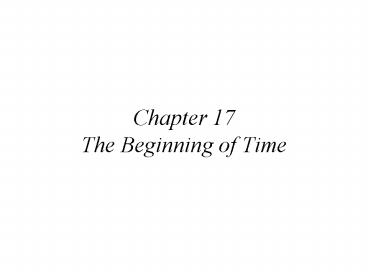Chapter 17 The Beginning of Time - PowerPoint PPT Presentation
Title:
Chapter 17 The Beginning of Time
Description:
Amounts of matter and antimatter nearly equal ... Begins when matter annihilates remaining antimatter at about 0.001 sec. Nuclei begin to fuse ... – PowerPoint PPT presentation
Number of Views:38
Avg rating:3.0/5.0
Title: Chapter 17 The Beginning of Time
1
Chapter 17The Beginning of Time
2
17.1 The Big Bang
Our Goals for Learning What were conditions
like in the early universe? What is the history
of the universe according to the Big Bang theory?
3
What were conditions like in the early universe?
4
How do we know the Universe is expanding?
5
Universe must have been much hotter and denser
early in time
6
The early universe must have been extremely hot
and dense
7
Photons converted into particle-antiparticle
pairs and vice-versa E mc2 Early
universe was full of particles and radiation
because of its high temperature
8
What is the history of the universe according to
the Big Bang theory?
9
(No Transcript)
10
Planck Era Before Planck time (10-43 sec) No
theory of quantum gravity
11
Four known forces in universe Strong Force
Electromagnetism Weak Force Gravity
12
Which of the four fundamental forces in our
universe keeps you from sinking to the center of
the Earth?
- Electromagnetism
- Gravity
- Strong Nuclear Force
- Weak Nuclear Force
13
Do forces unify at high temperatures?
Four known forces in universe Strong Force
Electromagnetism Weak Force Gravity
14
Do forces unify at high temperatures?
Four known forces in universe Strong Force
Electromagnetism Weak Force Gravity
15
Do forces unify at high temperatures?
Four known forces in universe Strong Force
Electromagnetism Weak Force Gravity
16
Do forces unify at high temperatures?
Four known forces in universe Strong Force
Electromagnetism Weak Force Gravity
17
High temperatures needed for force unification
found at early times in our Universes history
18
GUT Era Lasts from Planck time (10-43 sec) to
end of GUT force (10-38 sec)
19
Electroweak Era Lasts from end of GUT force era
(10-38 sec) to end of era of electroweak force
(at about 10-10 sec, or one 10-billionth of a
second after the Big Bang)
20
Particle Era Amounts of matter and antimatter
nearly equal (Roughly 1 extra proton for every
109 proton-antiproton pairs!)
21
Era of Nucleo-synthesis Begins when matter
annihilates remaining antimatter at about 0.001
sec Nuclei begin to fuse
22
Era of Nuclei Helium nuclei form at age of about
3 minutes Universe has become too cool to blast
helium apart
23
Era of Atoms Atoms form at age of about 380,000
years Background radiation released
24
Era of Galaxies Galaxies form in substantial
numbers when universe has age 1 billion years
25
Primary Evidence for the Big Bang
- We have detected the leftover radiation from the
Big Bang. - The Big Bang theory correctly predicts the
abundance of helium and other light elements.
26
What have we learned?
- What were conditions like in the early
universe? - The early universe was filled with radiation and
elementary particles. It was so hot and dense
that the energy of radiation could turn into
particles of matter and antimatter, which then
collided and turned back into radiation.
27
What have we learned?
What is the history of the universe according
to the Big Bang theory?
28
Activity 50, pages 189-191
- Remember 1 parsec (pc) 3.26 light-years, the
distance light travels in 3.26 years - 1 megaparsec (Mpc) 1 million parsecs 3.26
million light-years, the distance light travels
in 3.26 million years
29
1. Galaxies A and B are both moving away from the
Milky Way. Which galaxy is moving away faster,
and by how much?
- Galaxy A is moving away about twice as fast as
Galaxy B is - Galaxies A and B are moving away at the same
speed - Galaxy B is moving away about twice as fast as
Galaxy A is
30
2. If you draw the best-fitting line through the
points on the graph, roughly where does it
intersect the edge of the graph?
- Distance 390 Mpc, velocity 31,000 km/s
- Distance 430 Mpc, velocity 31,000 km/s
- Distance 480 Mpc, velocity 31,000 km/s
- Distance 480 Mpc, velocity 28,000 km/s
31
3A. How long has Samantha been traveling?
- 15 minutes
- 2 hours
- 4 hours
- 6 hours
- 60 hours
- 240 hours
32
3B. What time does each galaxys distance divided
by its velocity represent?
- Time until the galaxy will merge with the Milky
Way - Time since the galaxy formed
- Time it takes for light to reach us from that
galaxy - Time since the Big Bang
33
3C. What are the distance and velocity
coordinates of the galaxy represented by the
ROUND grey dot?
- Distance400 Mpc, velocity30,000 km/s
- Distance400 Mpc, velocity28,000 km/s
- Distance390 Mpc, velocity25,000 km/s
34
3D. For a galaxy 400 Mpc away receding from us at
28000 km/s, what time do you calculate?
- 1.4 1010 years, or 1.4 billion years
- 1.3 1010 years, or 13 billion years
- 1.4 1010 years, or 14 billion years
- 4.0 1010 years, or 4.0 billion years
35
5. Who is most nearly correct, and why?
- Isabella, because the universe started out at one
point - Isabella, because we are at the center of the
observable universe - Diego, because the universe started out at one
point - Diego, because the time we calculate corresponds
to the time since the Big Bang































